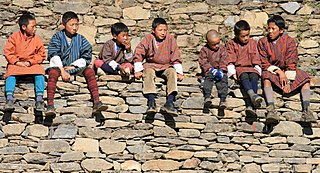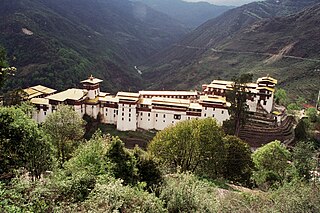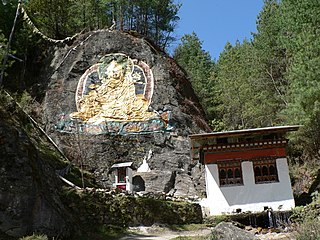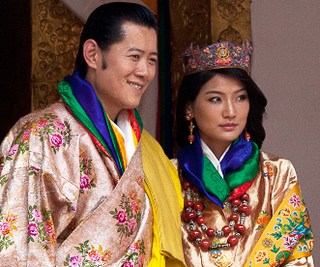
The Lhotshampa or Lhotsampa people are a heterogeneous Bhutanese people of Nepali descent. The Lhotshampa were estimated to comprise around 35% of the Bhutan's population by the U.S. Department of State as of 2008. The Lhotshampa are predominantly Hindu and speak the Nepali language.

Thimphu is the capital and largest city of Bhutan. It is situated in the western central part of Bhutan, and the surrounding valley is one of Bhutan's dzongkhags, the Thimphu District. The ancient capital city of Punakha was replaced by Thimphu as capital in 1955, and in 1961 Thimphu was declared as the capital of the Kingdom of Bhutan by the 3rd Druk Gyalpo Jigme Dorji Wangchuck.

Cradled in the folds of the Himalayas, Bhutan has relied on its geographical isolation to protect itself from outside cultural influences. A sparsely populated country bordered by India to the south, and China to the north, Bhutan has long maintained a policy of strict isolationism, both culturally and economically, with the goal of preserving its cultural heritage and independence. Only in the last decades of the 20th century were foreigners allowed to visit the country, and only then in limited numbers. In this way, Bhutan has successfully preserved many aspects of its culture, which dates directly back to the mid-17th century.

Dzong architecture is used for dzongs, a distinctive type of fortified monastery architecture found mainly in Bhutan and Tibet. The architecture is massive in style with towering exterior walls surrounding a complex of courtyards, temples, administrative offices, and monks' accommodation.
The Ngalop are people of Tibetan origin who migrated to Bhutan as early as the ninth century. Orientalists adopted the term "Bhote" or Bhotiya, meaning "people of Bod (Tibet)", a term also applied to the Tibetan people, leading to confusion, and now is rarely used in reference to the Ngalop.
Articles related to Bhutan include:

Bhutan, officially the Kingdom of Bhutan, is a landlocked country in South Asia situated in the Eastern Himalayas between China in the north and India in the south. With a population of over 727,145 and a territory of 38,394 square kilometres (14,824 sq mi), Bhutan ranks 133rd in land area and 160th in population. Bhutan is a constitutional monarchy with a king as the head of state and a prime minister as the head of government. The Je Khenpo is the head of the state religion, Vajrayana Buddhism.

The gho or g'ô is the traditional and national dress for men in Bhutan. Introduced in the 17th century by Ngawang Namgyal, 1st Zhabdrung Rinpoche, to give the Ngalop people a more distinctive identity, it is a knee-length robe tied at the waist by a cloth belt known as the kera. On festive occasions, it is worn with a kabney.

A kabney is a silk scarf worn as a part of the gho, the traditional male attire in Bhutan. It is raw silk, normally 90 cm × 300 cm with fringes. Kabney is worn over the traditional coat gho; it runs from the left shoulder to the right hip, and is worn at special occasions or when visiting a dzong. Kabney is also referred as Bura, which means wild silk.

Punakha is the administrative centre of Punakha dzongkhag, one of the 20 districts of Bhutan. Punakha was the capital of Bhutan and the seat of government until 1955, when the capital was moved to Thimphu. It is about 72 km away from Thimphu, and it takes about 3 hours by car from the capital. Unlike Thimphu, it is quite warm in winter and hot in summer. It is located at an elevation of 1,200 metres above sea level, and rice is grown as the main crop along the river valleys of two main rivers of Bhutan, the Pho Chu and Mo Chu. Dzongkha is widely spoken in this district.

The Wangchuck dynasty have held the hereditary position of Druk Gyalpo of Bhutan since 1907. Prior to reunification, the Wangchuck family had governed the district of Trongsa as descendants of Dungkar Choji. They eventually overpowered other regional lords and earned the favour of the British Empire. After consolidating power, the 12th Penlop of Trongsa Gongsar Ugyen Wangchuck was elected Druk Gyalpo, thus founding the dynasty. The position of Druk Gyalpo – who heads the royal family of Bhutan – is more commonly known in English as the King of Bhutan, however "Druk Gyalpo" would be translated literally as "Dragon King"
Immigration to Bhutan has an extensive history and has become one of the country's most contentious social, political, and legal issues. Since the twentieth century, Bhutanese immigration and citizenship laws have been promulgated as acts of the royal government, often by decree of the Druk Gyalpo on advice of the rest of government. Immigration policy and procedure are implemented by the Lhengye Zhungtshog Ministry of Home and Cultural Affairs, Department of Immigration. Bhutan's first modern laws regarding immigration and citizenship were the Bhutanese Citizenship Act 1958 and subsequent amendments in 1977. The 1958 Act was superseded by the Bhutanese Citizenship Act 1985, which was then supplemented by a further Immigration Act in 2007. The Constitution of 2008 included some changes in Bhutan's immigration laws, policy, and procedure, however prior law not inconsistent with the 2008 Constitution remained intact. Bhutan's modern citizenship laws and policies reinforce the institution of the Bhutanese monarchy, require familiarity and adherence to Ngalop social norms, and reflect the social impact of the most recent immigrant groups.

Bhutanese architecture consists of Dzong and everyday varieties. Dzongs in Bhutan were built as fortresses and have served as religious and administrative centers since the 17th century. Secular lordly houses emerged as a distinct style in the late 19th century, during a period of relative peace in Bhutan. Throughout its history, Bhutan has mainly followed the Buddhist architecture.

Bhutanese art is similar to Tibetan art. Both are based upon Vajrayana Buddhism and its pantheon of teachers and divine beings.
The national symbols of Bhutan include the national flag, national emblem, national anthem, and the mythical druk thunder featured in all three. Other distinctive symbols of Bhutan and its dominant Ngalop culture include Dzongkha, the national language; the Bhutanese monarchy; and the driglam namzha, a seventeenth-century code on dress, etiquette, and dzong architecture. Natural symbols of Bhutan are its national flower, the Himalayan blue poppy; its national tree, the Himalayan cypress; its national bird, the raven; and its national animal, the takin.

The wedding of Jigme Khesar Namgyel Wangchuck, King of Bhutan, and Jetsun Pema took place on 13 October 2011 at the Punakha Dzong in Punakha, Bhutan. The current King of Bhutan, Jigme Khesar Namgyel Wangchuck, married Jetsun Pema, who became Queen Ashi Jetsun Pema Wangchuck. Both are descendants of the 48th Druk Desi of Bhutan and 10th Penlop of Trongsa, Jigme Namgyal.

The Kho(ཁོ) is a traditional dress worn by Bhutia, ethnic Sikkimese people of Sikkim and Nepal. It is a loose, cloak-style garment that is fastened at the neck on one side and near the waist with a silk or cotton belt similar to the Tibetan chuba and to the Ngalop gho of Bhutan, but sleeveless.

A toego or tego is a long-sleeved, short jacket-like garment worn over a kira by women in Bhutan. The toego is thus part of the national dress of Bhutan required by the driglam namzha along with the kira, the wonju and the rachu.

A wonju is a long-sleeved blouse worn by women in Bhutan. Made of silk, polyester, or lightweight cotton, it is worn underneath the Kira, part of the national costume under the driglam namzha.
A kera is a cloth belt, a key element of Bhutanese traditional attire used to tie Gho and Kira, functioning as a type of sash or waistband.
















